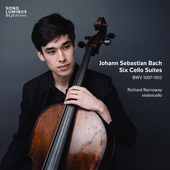Bach: 6 Cello Suites, Bwv 1007-1012
Label: SONO LUMINUS Catalog: SLE-70010 Format: CD Narroway, RichardBach’s Six Cello Suites There are a few iconic works in the core repertory with a special quality that makes them instantly recognizable, even after hearing just a few notes. The first G major Cello Suite is one of them. I like to think of the opening measures as a kind of entrance into the sound world of the cello; the open strings lift our spirits, resonating with the quintessential voice and depth of sonority we all know and love. It is so simple in its design, but so far-reaching in its vision, almost as if Bach is on a quest to discover the true potential of this instrument that has for too long been left in the background. As such, a feeling of birth and youthful discovery permeates the mood of this opening suite—a blissful disregard of any trials to come. And yet at the same time one gets the sensation that this is just the beginning of a larger journey. Richard’s Approach: “For this recording, I use a modern setup: specifically a 1930 Carl Becker cello made in Chicago, and a modern bow. I admit that such a setup is quite far off from the sound world that Bach must have imagined when composing these suites. I have done my best, however, to balance this modern setup with a thorough understanding of Baroque stylistic principles, particularly in regard to sound production, bow strokes, vibrato, slurring, voicing, and ornaments. I think nowadays, our performance decisions tend to be too black and white; one either performs with total commitment to historical performance practice (by using gut strings, a baroque bow, lower tuning and no endpin) or one forgets all about it. I don’t think it is so simple! There is plenty of room, I think, to combine an understanding of historical stylistic principles with current trends in modern performance practice. It is by no means as simple as choosing one way or the other. I think ultimately, regardless of what kind of setup one uses, how much one vibrates and so on, the most important thing is that the spirit of the music comes to life, which is often more a matter of phrasing, sound, character, tempo and attention to harmony, than of specific issues of Baroque tuning and style. The very fact that Bach’s suites can still reveal their secrets through so many varied approaches is a testament to the genius of this music. This is not to say that one should disregard any helpful musicological research that sheds light on performing traditions of the time. On the contrary, I think this is absolutely essential! There is nothing wrong with informing ourselves if the goal is to become more convincing, thoughtful artists. The information is there; why ignore it? At any rate, this kind of knowledge should not be confining. Rather, it should liberate us, for it offers an opportunity to open our minds and creative palettes to more colors and possibilities.” Recognized for his stylistic versatility and wide-ranging musical interests, Australian cellist Richard Narroway has proven himself to be equally at home with repertoire both new and old. He has appeared as a soloist with the Grand Rapids Symphony and the HanZhou Philharmonic Orchestra, and in recital on Chicago’s WFMT Dame Myra Hess Series and the Keys to the City Piano Festival at Chicago’s Symphony Center. In addition he has given performances in Australia, China, Germany, Canada and the United States, in prestigious venues such as the Kennedy Center, Chicago Symphony Center, Preston Bradley Hall and the Sydney Opera House.  Price: $25.98 Price: $25.98 |












